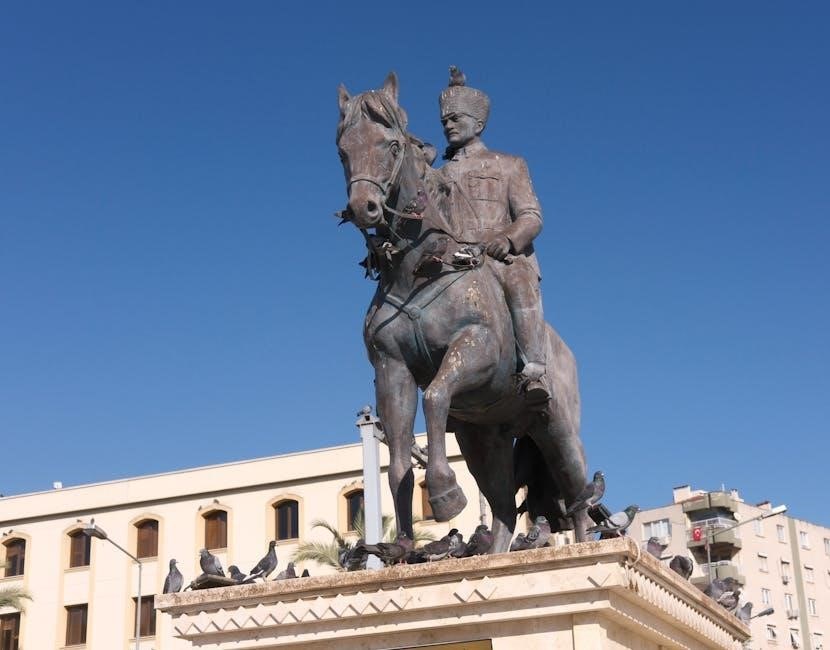Ilya Kaminsky, a celebrated poet born in Odessa, USSR, now based in the US, explores themes of resistance and resilience in his works, notably Deaf Republic.
Biographical Background
Ilya Kaminsky, born in Odessa, Ukraine, in the former Soviet Union, immigrated to the United States with his family at a young age. His experiences of displacement and adapting to a new culture deeply influenced his writing. Kaminsky, who is deaf, draws from his unique perspective to explore themes of identity and resilience. A renowned poet and professor, he has gained acclaim for his lyrical and emotionally charged works. His personal story intertwines with the narratives in Deaf Republic, reflecting his journey of self-discovery and connection to both his heritage and his adopted homeland.

Previous Works and Recognition
Ilya Kaminsky’s literary career is marked by critical acclaim and numerous awards. His debut collection, Dancing in Odessa (2004), received the Whiting Prize and the American Academy of Arts and Letters’ Metcalf Award. This recognition established him as a prominent voice in contemporary poetry. Kaminsky’s work often explores themes of identity, displacement, and social justice, resonating with readers globally. His unique style and profound storytelling have earned him a reputation as a masterful poet, setting the stage for the success of his subsequent works, including Deaf Republic, which continues to garner widespread praise and accolades.
Overview of “Deaf Republic”
Deaf Republic, Ilya Kaminsky’s second poetry collection, was published by Graywolf Press in 2019. This book-length series of poems explores themes of identity, resistance, and collective resilience.
Publishing Details
Deaf Republic was published by Graywolf Press in 2019, marking Ilya Kaminsky’s second poetry collection. The book comprises 76 pages, offering a powerful exploration of identity, resistance, and collective resilience. Released to critical acclaim, it has been celebrated for its unique narrative structure and emotional depth. The collection has gained widespread recognition, further solidifying Kaminsky’s reputation as a leading voice in contemporary poetry. The book is available in various formats, including PDF and EPUB, making it accessible to a broad audience. Its publication has been a significant milestone in modern poetry, resonating with readers globally.
Central Themes and Messages
Deaf Republic by Ilya Kaminsky delves into profound themes of deafness, identity, and resistance. The collection explores how silence can be both a form of oppression and a source of strength, reflecting the resilience of marginalized communities. Through intimate portrayals of personal and collective struggles, Kaminsky highlights the power of love and solidarity in the face of violence. The poems also serve as an urgent plea for social justice, weaving together personal narratives with broader political commentary. This duality creates a work that is both deeply personal and universally resonant, offering a powerful commentary on human rights and survival.

Themes in “Deaf Republic”
Deaf Republic explores themes of deafness, resistance, and resilience, weaving personal and collective struggles into a powerful narrative of survival and defiance against oppression.
Deafness and Identity
Deafness and Identity are central themes in Deaf Republic, where Kaminsky portrays deafness not as a limitation but as a unique identity fostering resilience and community. The poems explore how characters navigate a world hostile to their silence, finding strength in their shared experiences. Through vivid imagery, Kaminsky highlights the richness of a culture shaped by silence, challenging societal norms that equate deafness with disability. This perspective transforms deafness into a symbol of resistance and unity, celebrating the beauty of a community bound by its differences.
Resistance and Protest
Resistance and Protest are woven into the fabric of Deaf Republic, as Kaminsky’s characters confront oppression with courage and unity. The poems depict a community silenced by violence yet empowered by their collective defiance. Through symbolic acts of resistance, such as refusing to hear the oppressor, the townspeople assert their identity and humanity. Kaminsky’s portrayal of protest is both intimate and powerful, illustrating how resilience becomes a form of rebellion. This theme resonates universally, transcending the specific context to speak to all who have faced marginalization and fought for their rights.

Violence and Oppression
Violence and Oppression are central to the narrative of Deaf Republic, as the poems unfold against a backdrop of state-sanctioned brutality and societal marginalization. Kaminsky vividly portrays how violence disrupts lives, silencing individuals and communities. The regime’s oppression is both physical and psychological, creating an atmosphere of fear and control. Yet, amidst this darkness, the characters’ resilience shines through, as they find ways to resist and survive. The poems do not shy away from depicting the horrors of violence but also reveal the strength of those who endure it, making it a powerful exploration of human suffering and endurance.
Love and Resilience
Love and Resilience are enduring forces in Deaf Republic, offering hope amidst oppression. The bond between Alfonso and Sonya, a young couple expecting a child, becomes a symbol of tenderness and strength. Their love transcends the chaos, serving as a quiet defiance against violence. Kaminsky portrays resilience not only in personal relationships but also in the collective spirit of the community. The townspeople, though silenced by oppression, find ways to communicate and support one another, showing that even in darkness, love and hope persist. This duality underscores the human capacity to endure and resist, making their story both poignant and powerful.
Literary Style and Devices
Kaminsky’s Deaf Republic employs vivid imagery and symbolism, weaving a powerful narrative through episodic storytelling. His poetic devices create emotional depth, drawing readers into the world of resistance and silence.
Imagery and Symbolism
In Deaf Republic, Kaminsky uses striking imagery to convey the tension between silence and sound. Symbols like the deaf town and sign language represent resilience and unity. The poems are rich with visual metaphors that highlight resistance against oppression, creating a vivid emotional landscape. Kaminsky’s symbolism transforms everyday objects into powerful political statements, emphasizing the struggle for freedom and identity. His imagery not only reflects the physical world but also the inner lives of his characters, blending the personal with the collective. This duality enriches the narrative, making it both deeply personal and universally relatable.
Narrative Structure
Deaf Republic is structured as a series of interconnected poems, unfolding episodically like a play. The narrative begins with a tragic event, setting the tone for a story that blends personal and collective experiences. Kaminsky’s use of a fragmented yet cohesive structure mirrors the disjointedness of life under oppression. The poems move seamlessly between public violence and intimate personal moments, creating a dynamic tension. This structure allows Kaminsky to explore themes of resistance, love, and resilience, weaving together the lives of characters like Alfonso and Sonya. The episodic format enhances the emotional depth, making the narrative both urgent and timeless.
Episodic Storytelling

Deaf Republic employs episodic storytelling, with each poem functioning as a scene in a larger narrative; This format allows Kaminsky to explore the lives of characters like Alfonso and Sonya, blending public and private moments. The episodic structure builds tension, reflecting the fragmented nature of life under oppression. Each poem deepens the emotional and symbolic layers of the story, creating a sense of urgency and intimacy. Kaminsky’s use of this technique mirrors the disjointedness of reality, while also maintaining a cohesive flow. The result is a powerful, immersive narrative that resonates with readers on both personal and collective levels.

Reception and Reviews
Deaf Republic is critically acclaimed, winning several awards for its powerful narrative. Its emotional depth and urgent plea resonate deeply with readers, highlighting themes of resistance and love.
Critical Acclaim and Awards
Deaf Republic received widespread critical acclaim upon its release. It was named a finalist for the National Book Award and won the Kingsley Tufts Poetry Award. Critics praised Kaminsky’s masterful use of imagery and symbolism, which brought depth to the narrative. The collection was also recognized for its innovative storytelling, blending personal and collective experiences. Its exploration of themes such as resistance and resilience resonated deeply with readers and scholars alike. The book’s success solidified Kaminsky’s reputation as a leading voice in contemporary poetry, particularly in the realm of disability poetics.
Reader Responses
Readers have embraced Deaf Republic for its emotional depth and universal themes. Many praised Kaminsky’s ability to weave personal and collective narratives, creating a relatable yet profound experience. The book’s exploration of resilience, love, and resistance resonated deeply, with readers highlighting its accessibility and poetic beauty. The episodic structure and vivid imagery were particularly noted for their ability to engage and move readers. The collection has also sparked discussions on disability and identity, further cementing its impact. Its availability in formats like PDF and EPUB has made it widely accessible, contributing to its popularity and enduring appeal among diverse audiences worldwide.

Character Analysis
The characters in Deaf Republic, such as Alfonso and Sonya, embody resilience and love amidst oppression. The townspeople, collectively, symbolize a community united in silent resistance and hope.

Alfonso and Sonya
Alfonso and Sonya, central figures in Deaf Republic, represent enduring love and resilience. Their relationship, marked by tenderness and strength, serves as a beacon of hope amidst the oppressive regime. Sonya’s pregnancy symbolizes life’s persistence, while Alfonso’s actions embody resistance; Through their struggles, Kaminsky highlights the human spirit’s capacity to endure and inspire. Their story intertwines personal intimacy with collective rebellion, making them powerful symbols of both love and defiance in the face of oppression;
Townspeople and Community
The townspeople in Deaf Republic are portrayed as a collective entity bound by shared experiences of oppression and resistance. Their silent protests and acts of defiance highlight the power of community in the face of tyranny. Kaminsky depicts their lives as intertwined, creating a vivid tapestry of resilience. The townspeople’s unity becomes a source of strength, showing how collective action can challenge authority. Their stories, woven into the fabric of the narrative, illustrate the human capacity for solidarity and hope, even in the darkest moments. Through their struggles, Kaminsky underscores the enduring spirit of a community united against injustice.

Availability and Downloads
Deaf Republic by Ilya Kaminsky is available in multiple formats, including PDF and EPUB, for easy access. Readers can download the book from various online platforms.
PDF and EPUB Options
Readers can access Deaf Republic in both PDF and EPUB formats, ensuring compatibility with various devices. These digital versions are available for download from multiple sources online, offering convenience.
Free Access Resources
Multiple platforms offer Deaf Republic for free download in PDF, EPUB, and text formats. Websites like Handycraftedlibrary.blogspot.com provide direct links, making the collection accessible to a wider audience.

Literary Context
Deaf Republic bridges modernism and contemporary poetry, placing disability poetics at the forefront. It reflects a blending of personal and political narratives, resonating with modern literary trends.
Modernism and Disability Poetics
Deaf Republic stands at the intersection of modernism and disability poetics, blending experimental form with deeply personal narratives. Kaminsky’s use of imagery and symbolism challenges traditional representations of deafness, repositioning it as a metaphor for resistance and resilience. The collection’s episodic structure, reminiscent of modernist fragmented narratives, reflects the disjointedness of lived experience under oppression. By centering deafness as both a cultural identity and a political act, Kaminsky redefines disability poetics, offering a powerful critique of societal norms and violence. This fusion of modernist techniques and disability perspectives creates a groundbreaking work that resonates widely in contemporary poetry;
Contemporary Poetry Trends
Deaf Republic aligns with contemporary poetry’s shift toward themes of identity, resistance, and social justice. Kaminsky’s work reflects a growing trend of blending personal and political narratives, creating a collective voice that speaks to marginalization. The use of episodic storytelling and poetic devices like imagery and symbolism resonates with readers seeking emotional depth and complexity. By addressing disability and oppression, Kaminsky contributes to a broader conversation in modern poetry about inclusivity and representation. This approach not only garners critical acclaim but also connects with readers on a personal level, making Deaf Republic a significant contribution to today’s literary landscape.
Ilya Kaminsky’s Deaf Republic is a masterpiece, offering a profound exploration of resistance and resilience through lyrical prose and haunting imagery, leaving an enduring impact on readers.
Impact and Legacy
Deaf Republic has left an indelible mark on contemporary poetry, earning critical acclaim and sparking conversations about disability, resistance, and identity. Its innovative storytelling and emotional depth have resonated widely, solidifying Kaminsky’s reputation as a leading voice in modern poetry. The book’s exploration of oppression and resilience has inspired both academic discussions and personal reflections, making it a pivotal work in disability poetics. Its influence continues to grow, shaping how readers and scholars engage with themes of identity and social justice in literature. Kaminsky’s work remains a testament to the power of poetry to challenge and transform societal norms.
Final Thoughts
Deaf Republic is a profound exploration of identity, resistance, and resilience, offering readers a deeply emotional and thought-provoking experience. Kaminsky’s masterful use of imagery and symbolism creates a vivid world that lingers long after the final page. The book’s themes of oppression, love, and defiance resonate universally, making it a significant work in contemporary poetry. Its availability in formats like PDF and EPUB ensures accessibility, allowing a wide audience to engage with its powerful message. Deaf Republic is not just a collection of poems but a testament to the enduring strength of the human spirit. Its legacy continues to inspire and challenge readers globally.



